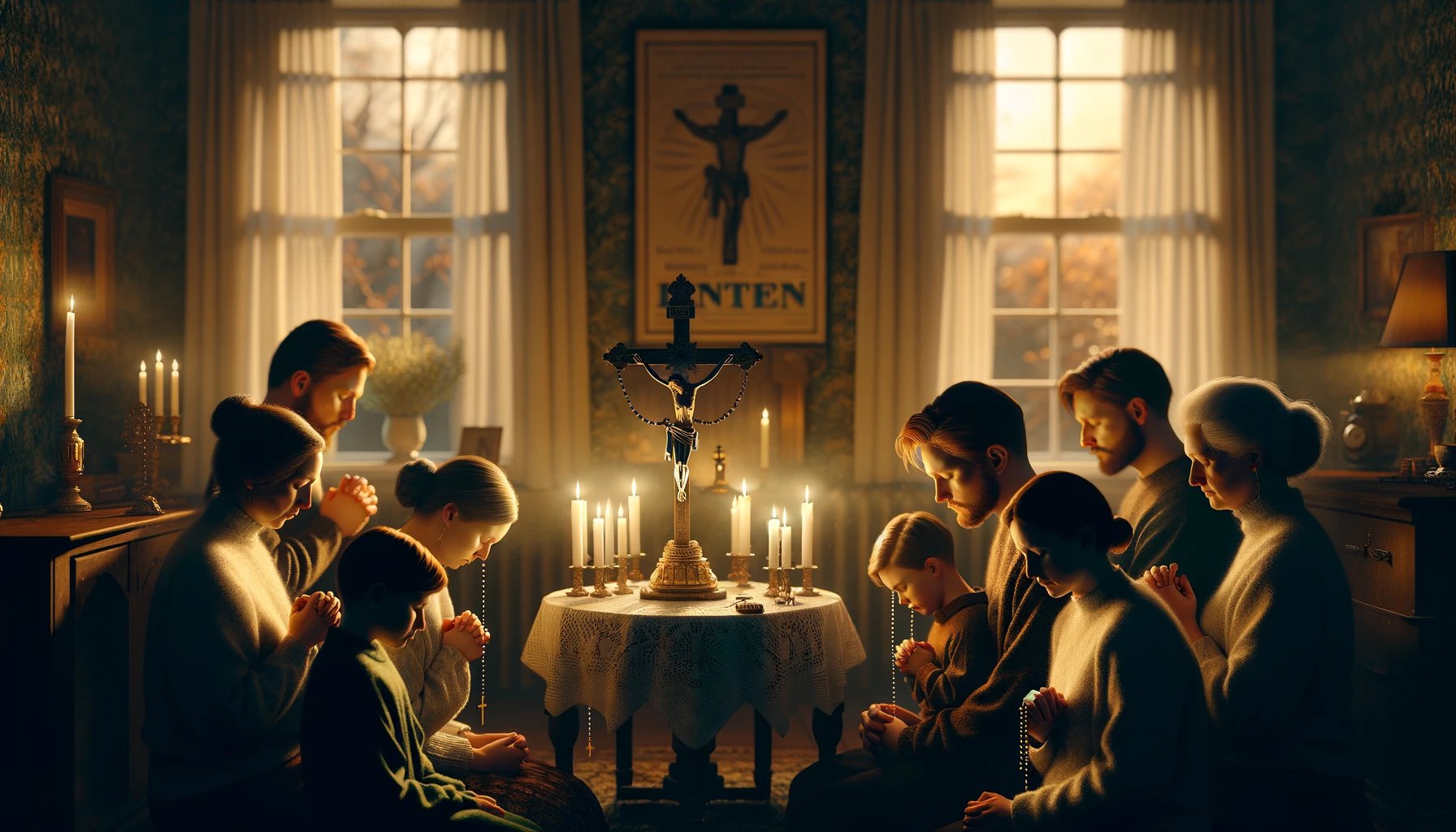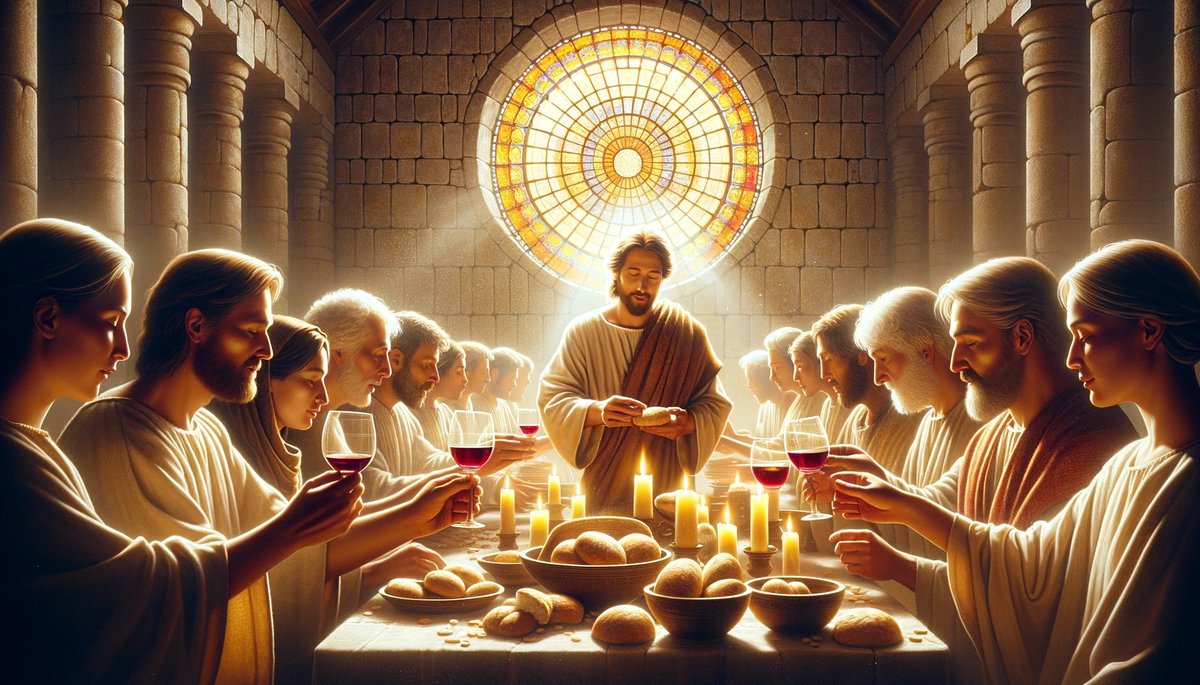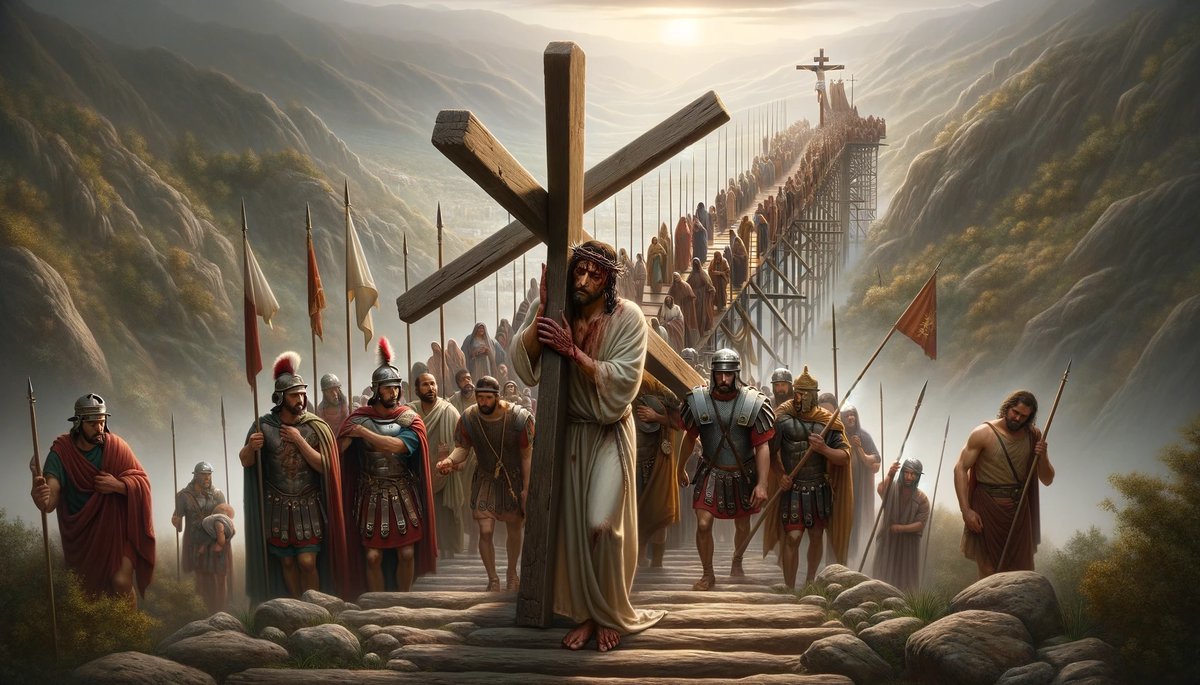Home>Special Themes>When Does Lent Start For The Catholics


Special Themes
When Does Lent Start For The Catholics
Published: February 27, 2024
Peter Smith, Editorial Director at Christian.net, combines deep insights into faith, politics, and culture to lead content creation that resonates widely. Awarded for his contributions to religious discourse, he previously headed a major organization for religious communicators, enhancing dialogue on faith's societal impacts.
Find out when Lent starts for Catholics and learn about the significance of this special season. Explore special themes and traditions associated with Lent.
(Many of the links in this article redirect to a specific reviewed product. Your purchase of these products through affiliate links helps to generate commission for Christian.net, at no extra cost. Learn more)
Table of Contents
The Significance of Lent in the Catholic Church
Lent holds immense significance in the Catholic Church as it is a period of reflection, repentance, and spiritual growth. It is a time when Catholics commemorate the 40 days that Jesus spent fasting in the desert, enduring temptation, and preparing for his public ministry. The season of Lent is a solemn and sacred time for Catholics to deepen their relationship with God, seek forgiveness for their sins, and renew their commitment to living a life of faith.
-
Spiritual Renewal: Lent serves as a time for spiritual renewal and growth. Catholics are encouraged to engage in prayer, fasting, and almsgiving to strengthen their connection with God and their fellow human beings.
-
Repentance and Forgiveness: It is a period for Catholics to reflect on their actions, seek forgiveness for their sins, and reconcile with God and others. This introspective period allows individuals to acknowledge their shortcomings and seek reconciliation through the sacrament of confession.
-
Preparation for Easter: Lent prepares Catholics for the celebration of Easter, the most significant event in the Christian calendar. By engaging in acts of self-discipline and spiritual reflection, Catholics prepare themselves to fully embrace the joy and significance of the resurrection of Jesus Christ.
-
Embracing Sacrifice: During Lent, Catholics are called to embrace sacrifice and self-denial, mirroring the sacrifices made by Jesus. This practice helps individuals to detach from worldly distractions and focus on their spiritual journey.
-
Community and Solidarity: Lent also fosters a sense of community and solidarity among Catholics. Many engage in acts of charity and service to support those in need, reflecting the compassionate teachings of Jesus Christ.
In essence, Lent holds a profound significance in the Catholic Church, serving as a period of introspection, spiritual growth, and preparation for the joyous celebration of Easter. It is a time for Catholics to recommit themselves to their faith, seek forgiveness, and embrace the teachings of Jesus Christ.
Read more: When Does Coptic Lent Start
Understanding the Lenten Season
The Lenten season, spanning 40 days, holds a special place in the hearts of Catholics worldwide. It begins on Ash Wednesday and concludes on Holy Thursday, leading into the Easter Triduum. This period symbolizes the 40 days Jesus spent fasting in the desert, enduring temptation, and preparing for his ministry. Lent is a time of reflection, self-examination, and spiritual growth. It encourages Catholics to engage in acts of penance, prayer, and almsgiving, fostering a deeper connection with God and a renewed commitment to living out the teachings of Jesus Christ.
The Spiritual Journey of Lent
Lent is a spiritual journey that invites Catholics to delve into the depths of their faith. It is a time to reevaluate one's relationship with God, seek forgiveness for past wrongs, and embrace a spirit of humility and repentance. Through prayer and meditation, individuals are encouraged to draw closer to God, seeking guidance and strength to overcome personal challenges and grow in their faith.
Self-Discipline and Sacrifice
Central to the Lenten season is the practice of self-discipline and sacrifice. Catholics are called to emulate the selflessness of Jesus by engaging in acts of fasting and abstinence. By giving up certain luxuries or indulgences, individuals are reminded of the importance of spiritual nourishment over material desires. This act of self-denial serves as a reminder of the ultimate sacrifice made by Jesus for the salvation of humanity.
Almsgiving and Acts of Charity
Lent also emphasizes the significance of almsgiving and acts of charity. Catholics are encouraged to reach out to those in need, offering assistance and support to the less fortunate. This practice reflects the compassionate teachings of Jesus, who emphasized the importance of caring for the marginalized and vulnerable members of society. Through acts of kindness and generosity, individuals embody the spirit of love and compassion that lies at the core of the Christian faith.
Read more: When Does Lent Start and What Is It?
Preparation for Easter
While Lent is a period of solemn reflection, it ultimately leads to the joyous celebration of Easter. The Lenten season prepares Catholics to fully embrace the significance of the resurrection of Jesus Christ. By engaging in acts of self-discipline, prayer, and repentance, individuals prepare their hearts and minds to experience the profound joy of Easter, commemorating the triumph of life over death and the promise of redemption.
In essence, the Lenten season is a time of spiritual introspection, self-discipline, and preparation for the celebration of Easter. It serves as a profound opportunity for Catholics to deepen their faith, seek reconciliation, and embrace the transformative power of God's love and mercy.
The History of Lent and Its Observance
-
Early Origins: The history of Lent can be traced back to the early centuries of Christianity. The observance of a period of fasting and preparation for Easter has roots in the practices of the early church. While the duration and specific practices of Lent varied in different regions, the underlying purpose remained consistent – to prepare believers for the celebration of the resurrection of Jesus Christ.
-
Development of 40 Days: The 40-day duration of Lent finds its significance in biblical references such as the 40 days of rain during the Great Flood and the 40 days Moses spent on Mount Sinai. The number 40 holds symbolic importance in the Christian tradition, signifying a period of testing, purification, and preparation. Over time, the 40-day observance became firmly established as a period of spiritual discipline and renewal.
-
Influence of Early Church Fathers: The observance of Lent was further shaped by the teachings of early church fathers such as St. Athanasius and St. Augustine. Their writings emphasized the importance of fasting, prayer, and repentance as essential elements of the Lenten season. Their influence contributed to the formalization of Lent as a significant period in the liturgical calendar.
-
Council of Nicaea: The Council of Nicaea, convened in 325 AD, played a pivotal role in standardizing the observance of Lent across the Christian community. The council affirmed the significance of the 40-day period of fasting and penance, aligning it with the biblical and historical foundations of the faith. This formal recognition solidified the observance of Lent as an integral part of the church's annual rhythm.
-
Evolution of Lenten Practices: Throughout history, the specific practices associated with Lent have evolved. While fasting and abstinence from certain foods have been enduring elements, additional customs such as the imposition of ashes, the Stations of the Cross, and special liturgical services have been incorporated into the Lenten observance. These practices serve to deepen the spiritual experience of believers and foster a sense of communal devotion.
-
Contemporary Observance: In modern times, the observance of Lent continues to hold a central place in the liturgical calendar of the Catholic Church. The faithful engage in acts of self-discipline, prayer, and almsgiving, seeking to emulate the example of Jesus Christ and prepare their hearts for the celebration of Easter. The historical legacy of Lent endures as a testament to the enduring significance of this sacred season in the life of the Church.
In summary, the history of Lent and its observance reflects the rich tapestry of tradition, spirituality, and faith that has characterized the Christian journey throughout the centuries. From its early origins to its contemporary expression, Lent remains a time-honored period of spiritual preparation and renewal for Catholics around the world.
The Date of Ash Wednesday and the Beginning of Lent
-
Calculation of Ash Wednesday: Ash Wednesday marks the commencement of the Lenten season and is determined based on the date of Easter Sunday. It falls 46 days before Easter, encompassing 40 days of fasting and reflection, excluding Sundays. As Easter Sunday varies each year, so does the date of Ash Wednesday. The earliest possible date for Ash Wednesday is February 4, and the latest is March 10.
-
Significance of Ashes: On Ash Wednesday, Catholics participate in the ritual of receiving ashes on their foreheads. The ashes, derived from the burning of palm branches blessed on the previous year's Palm Sunday, symbolize repentance and mortality. The priest applies the ashes in the form of a cross, reminding individuals of their call to turn away from sin and embrace the Gospel.
-
Observance of Ash Wednesday: The day holds great importance in the liturgical calendar, marking the beginning of the solemn Lenten season. Catholics are encouraged to attend Mass and receive the imposition of ashes as a visible sign of their commitment to spiritual renewal and repentance. The act of receiving ashes serves as a public declaration of one's desire to seek forgiveness and embark on a journey of self-examination and growth.
-
Preparation for Lenten Observance: Ash Wednesday sets the tone for the entire Lenten season, prompting Catholics to reflect on their spiritual priorities and prepare for the upcoming 40 days of prayer, fasting, and almsgiving. It serves as a poignant reminder of the transient nature of life and the need to prioritize one's relationship with God.
-
Lenten Discipline and Devotion: Following Ash Wednesday, Catholics embark on a period of self-discipline and spiritual devotion. The Lenten disciplines of fasting, abstinence, and intensified prayer become the focal points of individual and communal spiritual practice. The ashes received on Ash Wednesday serve as a tangible reminder of the commitment to these disciplines and the pursuit of spiritual growth.
-
Communal Participation: The observance of Ash Wednesday and the reception of ashes are communal acts, emphasizing the shared journey of faith among Catholics. The collective participation in this ritual reinforces the sense of unity and purpose as the faithful embark on the Lenten pilgrimage together, supporting one another in their spiritual endeavors.
In essence, Ash Wednesday marks the beginning of the Lenten season, inviting Catholics to embrace a period of introspection, repentance, and spiritual renewal. The reception of ashes on this day serves as a powerful symbol of one's commitment to the Lenten disciplines and the pursuit of a deeper connection with God.
How Catholics Prepare for Lent
-
Spiritual Reflection: Prior to the commencement of Lent, Catholics engage in deep spiritual reflection, assessing their lives and identifying areas for spiritual growth. This introspective period allows individuals to examine their relationship with God, seek forgiveness for past transgressions, and discern ways to strengthen their faith.
-
Reconciliation through Confession: The sacrament of confession, also known as reconciliation, holds particular significance as Catholics prepare for Lent. Many Catholics participate in the sacrament, confessing their sins to a priest and receiving absolution. This act of reconciliation allows individuals to enter the Lenten season with a renewed sense of spiritual purity and a commitment to living a life in accordance with their faith.
-
Setting Spiritual Goals: As part of their preparation, Catholics set spiritual goals for the Lenten season. These goals may include specific acts of self-discipline, increased prayer and meditation, and a focus on charitable works. By establishing clear objectives, individuals create a roadmap for their spiritual journey during Lent, fostering a sense of purpose and intentionality.
-
Fasting and Abstinence: Catholics prepare for Lent by considering the traditional practices of fasting and abstinence. This may involve discerning which luxuries or indulgences to give up during the Lenten period, as well as adhering to the regulations regarding meatless Fridays. The act of self-denial through fasting and abstinence serves as a tangible expression of one's commitment to spiritual discipline and sacrifice.
-
Prayer and Devotional Reading: In anticipation of Lent, Catholics often deepen their prayer life and engage in devotional reading. This may involve incorporating additional prayer sessions, attending spiritual retreats, or dedicating time to reading and meditating on sacred texts. By immersing themselves in prayer and spiritual literature, individuals prepare their hearts and minds for the transformative experience of Lent.
-
Participation in Ash Wednesday: The observance of Ash Wednesday serves as a pivotal moment in the preparation for Lent. Catholics make a concerted effort to attend Mass and receive the imposition of ashes, marking the beginning of their Lenten journey. The act of receiving ashes symbolizes a commitment to the Lenten disciplines and a desire for spiritual renewal.
-
Acts of Charity and Almsgiving: Leading up to Lent, Catholics focus on acts of charity and almsgiving, extending compassion and support to those in need. This may involve volunteering at charitable organizations, donating to causes that serve the marginalized, and engaging in acts of kindness within their communities. By embodying the spirit of generosity, individuals cultivate a mindset of selflessness and empathy as they prepare for the Lenten season.
In essence, the preparation for Lent is a multifaceted process that encompasses spiritual reflection, reconciliation, goal-setting, and acts of self-discipline and charity. By engaging in these preparatory practices, Catholics ready themselves for a period of profound spiritual growth and renewal during the Lenten season.
Read more: When Does Advent Starts
Lenten Practices and Traditions in the Catholic Faith
The Lenten season is characterized by a myriad of practices and traditions that hold deep significance in the Catholic faith. These customs are designed to guide believers through a period of spiritual introspection, self-discipline, and devotion as they prepare for the celebration of Easter. The following are some of the prominent Lenten practices and traditions observed within the Catholic Church:
Fasting and Abstinence
Fasting and abstinence are central to the Lenten observance. Catholics between the ages of 18 and 59 are called to fast on Ash Wednesday and Good Friday, consuming only one full meal and two smaller meals that do not equal a full meal. Additionally, Catholics over the age of 14 are required to abstain from meat on Ash Wednesday and all Fridays during Lent. These practices serve as a tangible expression of self-discipline and solidarity with the sacrificial journey of Jesus Christ.
Stations of the Cross
The Stations of the Cross, also known as the Way of the Cross, are a series of 14 artistic representations or devotional stations that depict the events of Jesus' final journey to the crucifixion. Catholics often participate in the communal prayer of the Stations of the Cross, reflecting on the profound suffering and sacrifice of Jesus as they move from station to station. This tradition fosters a deep sense of empathy and reverence for the redemptive journey of Christ.
Almsgiving and Acts of Charity
Lent is a time for Catholics to engage in acts of charity and almsgiving, reflecting the compassionate teachings of Jesus Christ. Many individuals and communities dedicate themselves to supporting charitable causes, volunteering at local organizations, and extending assistance to those in need. By embodying the spirit of generosity, Catholics demonstrate their commitment to serving others and living out the values of compassion and solidarity.
Prayer and Devotional Practices
The Lenten season encourages Catholics to intensify their prayer life and engage in devotional practices that deepen their spiritual connection. This may include attending additional Masses, participating in communal prayer services, and dedicating time to personal prayer and meditation. The Lenten liturgical calendar also features specific prayers and readings that center on themes of repentance, redemption, and the journey to Easter.
Imposition of Ashes
The imposition of ashes on Ash Wednesday is a significant tradition that marks the beginning of the Lenten season. Catholics receive ashes on their foreheads in the form of a cross, symbolizing their mortality and the call to repentance. The act of receiving ashes serves as a visible sign of one's commitment to the Lenten disciplines and the pursuit of spiritual renewal.
Lenten Retreats and Spiritual Exercises
Many Catholics participate in Lenten retreats and spiritual exercises to deepen their understanding of the season's significance. These retreats provide opportunities for individuals to withdraw from the distractions of daily life, engage in focused prayer and reflection, and seek spiritual guidance. Lenten retreats offer a space for profound introspection and renewal, allowing participants to immerse themselves in the spiritual journey of Lent.
In essence, Lenten practices and traditions in the Catholic faith encompass a rich tapestry of customs that guide believers through a period of spiritual preparation and growth. These observances serve to deepen the connection with God, foster a spirit of selflessness, and prepare individuals to fully embrace the joy of Easter.
The End of Lent: Holy Week and Easter Sunday
The culmination of the Lenten season is marked by Holy Week, a profoundly significant period in the Catholic calendar that leads to the celebration of Easter Sunday. Holy Week commences with Palm Sunday, commemorating Jesus' triumphant entry into Jerusalem, and concludes with the Easter Vigil and Easter Sunday, rejoicing in the resurrection of Christ. This sacred week is characterized by a series of liturgical events and traditions that encapsulate the core tenets of the Christian faith.
Read more: How Long Does Catholic Lent Last
Palm Sunday: Commemorating Jesus' Entry into Jerusalem
Palm Sunday, the beginning of Holy Week, is a time of jubilation and reflection as Catholics commemorate Jesus' entry into Jerusalem, greeted by crowds waving palm branches. The liturgy includes the blessing of palms and a procession, symbolizing the joyful welcome extended to Jesus as the Messiah. However, the mood shifts as the readings recount the events leading to Jesus' crucifixion, setting the stage for the solemn observances of the following days.
Holy Thursday: The Institution of the Eucharist and the Priesthood
Holy Thursday, also known as Maundy Thursday, marks the institution of the Eucharist and the priesthood by Jesus at the Last Supper. Catholics participate in the Mass of the Lord's Supper, where the ritual of the washing of the feet is reenacted, symbolizing the call to humble service and selfless love. The liturgy concludes with the solemn transfer of the Blessed Sacrament to the Altar of Repose, inviting believers to enter into a period of prayer and vigil.
Good Friday: Commemorating the Crucifixion of Jesus
Good Friday stands as a day of solemn remembrance, marking the crucifixion and death of Jesus Christ. Catholics participate in the liturgical service of the Lord's Passion, which includes the veneration of the Cross and the solemn reading of the Gospel accounts of Jesus' crucifixion. The atmosphere is one of reverence and contemplation, as believers reflect on the profound sacrifice made by Jesus for the redemption of humanity.
Easter Vigil: The Celebration of Christ's Resurrection
The Easter Vigil, the most significant liturgical event of the year, takes place on Holy Saturday evening. It begins with the blessing of the Easter fire and the lighting of the Paschal Candle, symbolizing the light of Christ dispelling the darkness of sin and death. The vigil features a series of readings that recount salvation history, culminating in the proclamation of the resurrection of Jesus Christ. The faithful rejoice in the triumph of life over death as the church is illuminated, and the Gloria is sung once again.
Read more: When Does The Lenten Fast End?
Easter Sunday: The Joyous Celebration of Resurrection
Easter Sunday, the pinnacle of the liturgical year, is a day of exultant celebration as Catholics rejoice in the resurrection of Jesus Christ. The Mass of Easter Sunday is marked by the proclamation of the Gospel accounts of the empty tomb and the appearances of the risen Christ. The church resounds with joyful hymns and the Alleluia, signifying the victory of Christ over sin and death. Families and communities gather to share in festive meals and extend greetings of "Christ is risen, Alleluia!" as they embrace the promise of new life and redemption.
In essence, Holy Week and Easter Sunday represent the culmination of the Lenten journey, encapsulating the foundational beliefs of the Catholic faith. These sacred observances invite believers to immerse themselves in the profound mysteries of Christ's passion, death, and resurrection, reaffirming the central tenets of redemption, hope, and the transformative power of God's love.










